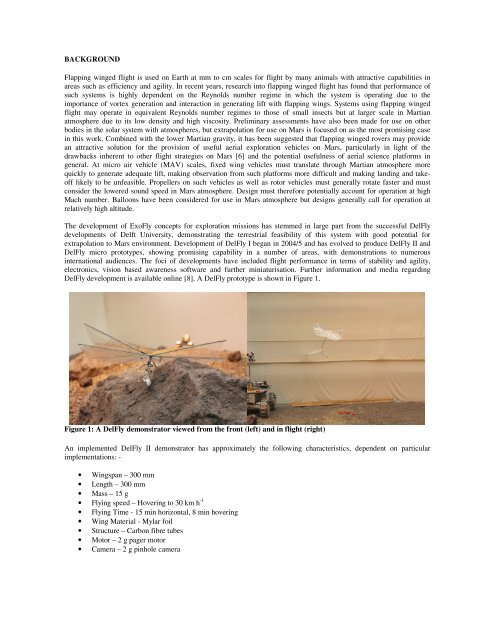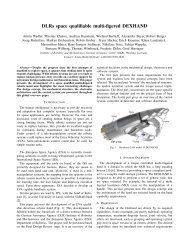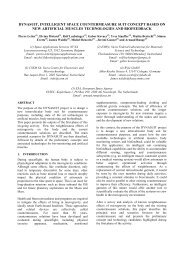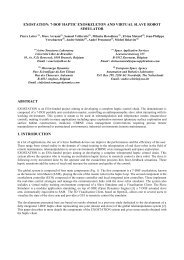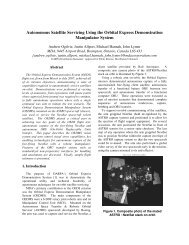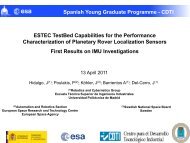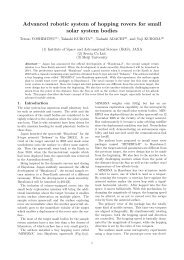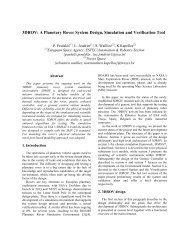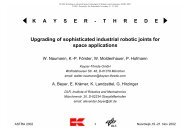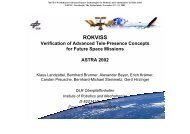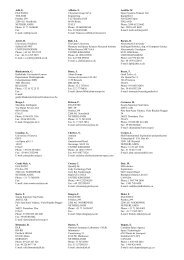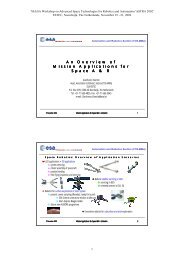EXOFLY: A FLAPPING WINGED AEROBOT FOR ... - Robotics - ESA
EXOFLY: A FLAPPING WINGED AEROBOT FOR ... - Robotics - ESA
EXOFLY: A FLAPPING WINGED AEROBOT FOR ... - Robotics - ESA
You also want an ePaper? Increase the reach of your titles
YUMPU automatically turns print PDFs into web optimized ePapers that Google loves.
BACKGROUND<br />
Flapping winged flight is used on Earth at mm to cm scales for flight by many animals with attractive capabilities in<br />
areas such as efficiency and agility. In recent years, research into flapping winged flight has found that performance of<br />
such systems is highly dependent on the Reynolds number regime in which the system is operating due to the<br />
importance of vortex generation and interaction in generating lift with flapping wings. Systems using flapping winged<br />
flight may operate in equivalent Reynolds number regimes to those of small insects but at larger scale in Martian<br />
atmosphere due to its low density and high viscosity. Preliminary assessments have also been made for use on other<br />
bodies in the solar system with atmospheres, but extrapolation for use on Mars is focused on as the most promising case<br />
in this work. Combined with the lower Martian gravity, it has been suggested that flapping winged rovers may provide<br />
an attractive solution for the provision of useful aerial exploration vehicles on Mars, particularly in light of the<br />
drawbacks inherent to other flight strategies on Mars [6] and the potential usefulness of aerial science platforms in<br />
general. At micro air vehicle (MAV) scales, fixed wing vehicles must translate through Martian atmosphere more<br />
quickly to generate adequate lift, making observation from such platforms more difficult and making landing and takeoff<br />
likely to be unfeasible. Propellers on such vehicles as well as rotor vehicles must generally rotate faster and must<br />
consider the lowered sound speed in Mars atmosphere. Design must therefore potentially account for operation at high<br />
Mach number. Balloons have been considered for use in Mars atmosphere but designs generally call for operation at<br />
relatively high altitude.<br />
The development of ExoFly concepts for exploration missions has stemmed in large part from the successful DelFly<br />
developments of Delft University, demonstrating the terrestrial feasibility of this system with good potential for<br />
extrapolation to Mars environment. Development of DelFly I began in 2004/5 and has evolved to produce DelFly II and<br />
DelFly micro prototypes, showing promising capability in a number of areas, with demonstrations to numerous<br />
international audiences. The foci of developments have included flight performance in terms of stability and agility,<br />
electronics, vision based awareness software and further miniaturisation. Further information and media regarding<br />
DelFly development is available online [8]. A DelFly prototype is shown in Figure 1.<br />
Figure 1: A DelFly demonstrator viewed from the front (left) and in flight (right)<br />
An implemented DelFly II demonstrator has approximately the following characteristics, dependent on particular<br />
implementations: -<br />
• Wingspan – 300 mm<br />
• Length – 300 mm<br />
• Mass – 15 g<br />
• Flying speed – Hovering to 30 km h -1<br />
• Flying Time - 15 min horizontal, 8 min hovering<br />
• Wing Material - Mylar foil<br />
• Structure – Carbon fibre tubes<br />
• Motor – 2 g pager motor<br />
• Camera – 2 g pinhole camera


